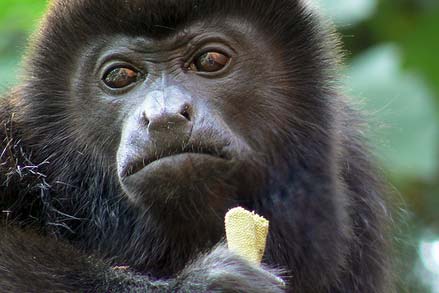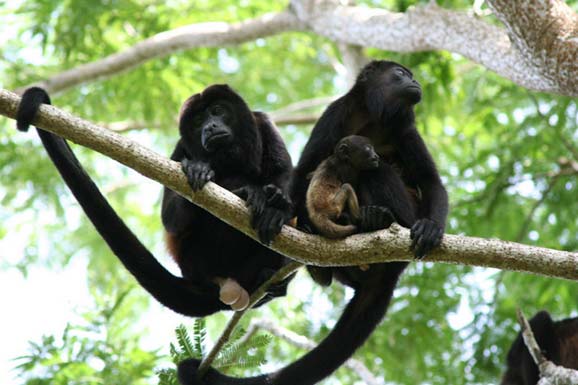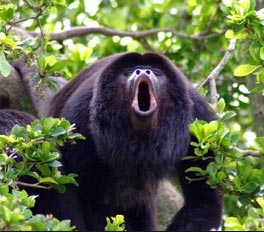Alone in the Jungle
Imagine being alone in a rain forest and hearing a terrifying growl that’s as loud and amplified as movie theater surround sound.
Panther? Puma? Maybe a rain forest animal you’ve never heard of? Odds are you have encountered a troop of gentle, leaf-eating howler monkeys. The big sound of a howler monkey is produced by the hyoid bone, a hollow bone near the vocal cords that amplifies sound. This bone in the male is 25 times larger than monkeys of a comparable size. The roar of the male can last several seconds and can be heard for 2 miles.
The sound is primarily used to locate other members of the troop, but howlers will also “go off” if disturbed or confronted by predators or more aggressive monkeys.



Family Dynamics
Despite their big voices, howlers are not particularly large. Males average around 15 pounds. They generally travel in families of 10 to 20 members although some groups will have as many as 40 members. Males outrank females, and younger animals of each gender have a higher rank than older animals.
Higher ranked animals get preference for food and resting sites. The alpha male has primary mating rights. An interesting aspect about family dynamics is how sexually mature animals are pushed out of the group and forced to start their own families.
This means that family groups are generally not related to each other. Biologists believe this forced genetic diversity helps keep the species thriving.
Where to See Them
Howlers (called congos in Spanish) have adapted better to urbanization than most Costa Rican animals. Troops can survive and even flourish in smaller territories, primarily due to their ability to digest many different types of leaves, fruit and flowers. You have a good chance of encountering howlers in Costa Rica’s national parks like La Selva, Corcovado, Santa Rosa, Arenal Volcano, Barra Honda and the Monteverde Cloud Forest.
But you can also see them in many areas outside the nature preserves. In Costa Rica/Manuel Antonio, you will see howlers while dining at area restaurants like El Avion, Raphael’s Terrazas and Byblos. Grocery shoppers at CoopAtenas in Atenas have been known to run their carts into each other in the parking lot when a troop of local howlers show up and put on an unforgettable auditory display in trees above the supermarket.
Best time to hear them howl is early morning and late afternoon.
Howler Facts
- Generally, howlers don’t interact with other Costa Rican monkeys, but occasionally they will eat with white-faced monkeys in the same tree while their babies play together.
- Videos show pumas stalking howlers.
- Unlike other species of New World monkeys, howlers can see in color as well as black and white.
- Howlers typically live 25 years.
- Females also howl but their sound is less intense and higher pitched.
- Howlers spend a large portion of the day resting because their primary source of food—leaves and flowers—are a low energy food source.

 +1 888-818-2097
+1 888-818-2097
 +506 8932-4731
+506 8932-4731